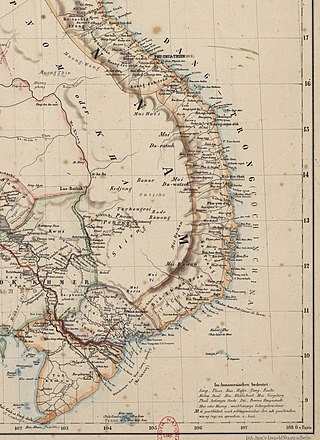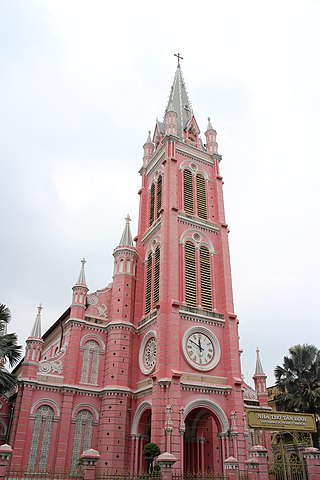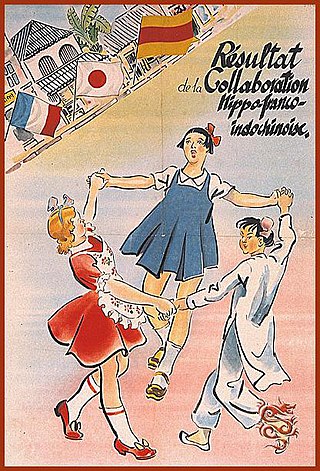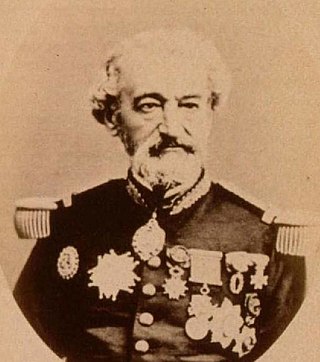Related Research Articles
Albert Peter Dewey was an American Office of Strategic Services operative shot to death in a case of mistaken identity by Communist aligned Viet Minh troops on September 26, 1945. Dewey was the first American fatality in French Indochina, killed during the 1945 Vietnamese uprising.
Notre Dame, French for "Our Lady", a title of Mary, mother of Jesus, most commonly refers to:

Cochinchina or Cochin-China is a historical exonym for part of Vietnam, depending on the contexts. Sometimes it referred to the whole of Vietnam, but it was commonly used to refer to the region south of the Gianh River.

French Cochinchina was a colony of French Indochina, encompassing the whole region of Lower Cochinchina or Southern Vietnam from 1862 to 1946. The French operated a plantation economy whose primary strategic product was rubber.

The Empire of Vietnam was a short-lived puppet state of Imperial Japan governing the former French protectorates of Annam and Tonkin between March 11 and August 25, 1945. At the end of its rule, the empire also successfully reclaimed Cochinchina as part of Vietnam.

Notre-Dame Cathedral Basilica of Saigon, officially Cathedral Basilica of Our Lady of The Immaculate Conception is a cathedral located in the downtown of Ho Chi Minh City, Vietnam. Established by French colonists who initially named it the Church of Saigon, the cathedral was constructed between 1863 and 1880. The name Notre-Dame Cathedral has been used since 1959. It has two bell towers, reaching a height of 58 meters (190 feet).
Notre Dame Basilica may refer to:

Tân Định church is a Roman Catholic church in Ho Chi Minh City, Vietnam. Its formal name is the Church of the Sacred Heart of Jesus. Even though it is in District 3, the parish shares its name with neighbouring District 1's Tân Định Ward.

The Archdiocese (Metropolitan) of Saigon or unofficial name is Archdiocese (Metropolitan) of Ho Chi Minh City is a Roman Catholic ecclesiastical territory in the south of Vietnam. It is the biggest by population in the country.It covers an area of 2,390 km2 (920 sq mi). The suffragan dioceses are:

The siege of Saigon, a two-year siege of the city by the Vietnamese after its capture on February 17, 1859 by a Franco-Spanish flotilla under the command of the French admiral Charles Rigault de Genouilly, was one of the major events of the Conquest of Cochinchina (1858–62). Saigon was of great strategic importance, both as the key food-producing area of Vietnam and as the gateway to Cochinchina.

Léonard Victor Joseph Charner was an Admiral of the French Navy. As a commander of French naval forces in Asia from May 1860 to September 1861, including the Second Opium War and the Cochinchina campaign, he was a significant participant in the establishment of French Indochina.

UNESCO designated the Routes of Santiago de Compostela in France as a World Heritage Site in December 1998. The routes pass through the following regions of France: Aquitaine, Auvergne, Basse-Normandie, Bourgogne, Centre, Champagne-Ardenne, Ile-de-France, Languedoc-Roussillon, Limousin, Midi-Pyrénées, Picardie, Poitou-Charentes, and Provence-Alpes-Côte d'Azur. UNESCO cites the routes' role in "religious and cultural exchange", the development of "specialized edifices" along the routes, and their "exceptional witness to the power and influence of Christian faith among people of all classes and countries in Europe during the Middle Ages".

The 1945–46 War in Vietnam, codenamed Operation Masterdom by the British, and also known as the Southern Resistance War by the Vietnamese, was a post–World War II armed conflict involving a largely British-Indian and French task force and Japanese troops from the Southern Expeditionary Army Group, versus the Vietnamese communist movement, the Viet Minh, for control of the southern half of the country, after the unconditional Japanese surrender.

In mid-1940, Nazi Germany rapidly defeated the French Third Republic, and the colonial administration of French Indochina passed to the French State. Many concessions were granted to the Nazi-allied Empire of Japan, such as the use of ports, airfields, and railroads. Japanese troops first entered parts of Indochina in September 1940, and by July 1941 Japan had extended its control over the whole of French Indochina. The United States, concerned by Japanese expansion, started putting embargoes on exports of steel and oil to Japan from July 1940. The desire to escape these embargoes and to become self-sufficient in resources ultimately contributed to Japan's decision to attack on December 7, 1941, the British Empire and simultaneously the USA. This led to the USA declaring war against Japan on December 8, 1941. The US then joined the side of the British Empire, at war with Germany since 1939, and its existing allies in the fight against the Axis powers.

1940—1946 in French Indochina focuses on events that happened in French Indochina during and after World War II and which influenced the eventual decision for military intervention by the United States in the Vietnam War. French Indochina in the 1940s was divided into four protectorates and one colony (Cochinchina). The latter three territorial divisions made up Vietnam. In 1940, the French controlled 23 million Vietnamese with 12,000 French soldiers, about 40,000 Vietnamese soldiers, and the Sûreté, a powerful police force. At that time, the U.S. had little interest in Vietnam or French Indochina as a whole. Fewer than 100 Americans, mostly missionaries, lived in Vietnam and U.S. government representation consisted of one consul resident in Saigon.

Achille-Antoine Hermitte was a French architect who is known for designing the Hong Kong City Hall and the Palais du Gouverneur, Saigon. His life is not well-documented and there is uncertainty about the date and place of his death. His only surviving building is the small Chapel of the Tomb of St Francis Xavier on St. John's Island, southwest of Canton (Guangzhou).

The Saigon Governor's Palace, also known as the Norodom Palace and then renamed Independence Palace, was a government building in Saigon, French Cochinchina, built between 1868 and 1873.

Marie-Jules Dupré was a French admiral. He was governor of Réunion from 1865 to 1869 under the Second French Empire, and governor of Cochinchina from 1871 to 1874 under the French Third Republic. He negotiated a treaty with the Emperor of Vietnam that opened up the country to French commerce and ceded territory in the south to France.

Paris Commune Square is a small square located in District 1, downtown Ho Chi Minh City, Vietnam. It lies between Lê Duẩn Boulevard and Nguyễn Du Street and surrounds the Notre-Dame Cathedral Basilica of Saigon. This is also the starting point of the famous Đồng Khởi Street. The square is surrounded by two remarkable architectural works: Notre-Dame Cathedral and Central Post Office.
The Treaty of Saigon was signed on 15 March 1874 by the Third French Republic and the Nguyễn dynasty of Vietnam. Vietnam made economic and territorial concessions to France, while France waived a previous war indemnity and promised military protection against China. The treaty effectively made Vietnam a protectorate of France.
References
- Vietnam statemen French Cochinchina (South Vietnam), World Statesmen
- Patti, Archimedes (1980). Why Viet Nam? Prelude to America's Albatross. Berkeley: University of California Press. ISBN 978-0520047839.